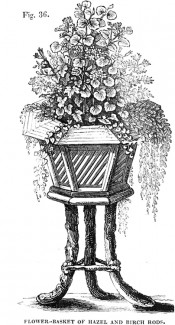
Johns Hopkins UniversityEst. 1876
America’s First Research University
Now Browsing:
Victorian Periodicals Review announces 2020 VanArsdel Prize Winner

The VanArsdel Prize is awarded annually to the best graduate student essay investigating Victorian periodicals and newspapers. The prize was established in 1990 to honor Rosemary VanArsdel, a founding member of the Research Society for Victorian Periodicals, whose groundbreaking research continues to shape the field of nineteenth-century periodical studies. The winner of the VanArsdel Prize receives $500 and publication in Victorian Periodicals Review.
The latest issue of Victorian Periodicals Review (VPR) includes the 2020 VanArsdel prize winning essay, “Vegetal Bedfellows: Houseplant Superstitions and Environmental Thought in Nineteenth-Century Periodicals” by University of Wisconsin-Madison PhD candidate Lindsay Wells. We asked the journal’s editor, Dr. Katherine Malone, to reflect on the award selection process, and this year’s winner, Lindsay Wells, to tell us more about her fascinating research.
Why is the VanArsdel Prize important?

Katherine Malone: Rosemary VanArsdel was not only a founding member of RSVP but also a generous mentor to students and early-career scholars. The VanArsdel Prize continues her legacy by recognizing the best graduate student writing. It's also an important part of RSVP’s mission to support innovative research in nineteenth-century newspapers and periodicals. In its early days, the prize encouraged graduate students to take on the challenges and pleasures of periodical studies, which relied on physical archives and special collections that were often difficult to access. Now that mass digitization and open-access archives have dramatically expanded our field, there is an even greater need for scholars to engage critically and creatively with these texts - in all their various formats. The VanArsdel Prize continues to incentivize that research, and it also invites students into a lively and supportive community of scholars.
Who determines the prize winner?
KM: Every year the VPR Editor invites two scholars in the field of Victorian periodicals to serve as judges, and applicants receive developmental feedback from these experts.
How many entries did you receive for the 2020 VanArsdel Prize? What set Ms. Wells’ essay apart?
KM: We receive about ten submissions per year, on average. The judges of our 2020 competition both noted that it was a difficult choice because we had so many strong submissions. Ultimately, Lindsay Wells’s essay stood out because of its insightful thesis and interdisciplinary research. The judges noted, “No question, this essay is excellent, entertaining, very well written, and it deals with subject matter that is very current in Victorian studies.” They praised the essay for “drawing on an impressively wide range of examples from a number of different periodicals to make a broader argument about the perpetuation of [the dangerous houseplant] myth while also making an argument for the interrelationship between humans and plants.”

What is your “academic origin story”? How did you come to study Art History and, more specifically, focus on 19th century British visual culture and gardening?
Lindsay Wells: I grew up on a raspberry farm in upstate New York, so plants have always been an important part of my life. Sometimes I wish I had followed in my dad’s footsteps and studied agriculture in college, but I also loved history and ended up enrolling at Penn State for undergrad as a Classics major. By the end of my sophomore year, I had decided to additionally major in Art History and Medieval Studies, and I began to focus on nineteenth-century British art after studying abroad at Oxford University. My interests in horticulture emerged during the first years of my PhD at the University of Wisconsin-Madison, where my art history professors let me write seminar papers about Victorian botany books and terrariums. The encouragement I received from the Department of Art History was vital to the development of my interdisciplinary research, while the courses I took in UW-Madison’s English Department shaped my interests in Victorian garden writing as a genre. For my dissertation, I analyzed representations of houseplants in the art of the British Aesthetic Movement (c.1860s-90s), with a focus on how indoor gardening trends (and, by extension, the Victorian paintings that referenced them) developed in tandem with imperial plant hunting and industrial pollution.
What sparked the thesis for your paper? Where did you first come upon warnings about indoor plants?
LW: As I studied nineteenth-century gardening books and journals for my dissertation, I kept encountering this debate about whether or not it was safe to sleep near houseplants, even after scientific research had disproven the fear that plants emitted harmful amounts of carbon dioxide at night. The breadth and diversity of texts that addressed this issue made me curious about its broader function within Victorian garden writing and cultural thought. What I found interesting was how, in many instances, horticultural writers would reference the debate not to warn readers about the potential hazards of houseplants, but to make larger statements about the importance of all plants to human health and environmental harmony. Given how prevalent these arguments are in modern discussions of gardening, I thought it would be worthwhile to analyze their history in more depth.
Reading your paper, it’s clear that “urban legends” that warn against (inaccurate) dangers have persisted for hundreds of years! What do you think your research can teach us about the persistence of “old wives’ tales”?

LW: One of the most important lessons I’ve learned through my research is that if something unusual keeps resurfacing in your sources, it probably deserves a closer look. On my visits to horticultural archives, I started taking note of Victorian concerns about dangerous houseplants both because they appeared so frequently in horticultural texts and because I was familiar with modern versions the same misconceptions. Anytime a story is continuously revisited or retold, I think it is worth investigating the larger narratives at play. Analyzing nineteenth-century discussions of houseplant safety made me realize just how important discussions of air quality and plant physiology were to Victorian garden writing. I believe that there are many more parallels to be explored between nineteenth- and twenty-first-century horticulture, especially with regards to how gardening shapes our perception of plants.
Is your paper part of any larger work?
LW: My article grew out of material that did not fit into my dissertation, and it is currently not part of a larger project. However, the piece reflects to my broader interests in Victorian garden writing as a site where environmental arguments about the vegetal world were forged and debated.
What’s next for you? What are you currently researching?
LW: I will definitely be staying in the plant world for the foreseeable future! I am currently completing a new essay on representations of vegetal movement in nineteenth-century British landscape paintings, as well as an essay on the drawings of Victorian artist Edward Burne-Jones. This fall I will be working on my current book project, “Evergreen Empire: The Horticultural Politics of British Painting, 1848-1910,” as an Ahmanson-Getty Postdoctoral Fellow at UCLA’s William Andrews Clark Memorial Library. My book analyzes how imperial plant hunting redefined the treatment of botanical imagery in Victorian art, with an emphasis on the Pre-Raphaelites, Aestheticism, and British Decadence.
Dr. Katherine Malone is Associate Professor of English at South Dakota State University, specializing in nineteenth-century British literature and culture. Her research focuses on women critics and the interplay of gender and genre in Victorian periodicals. She is the editor of Victorian Periodicals Review.
Lindsay Wells is a PhD candidate in the Department of Art History at the University of Wisconsin-Madison. Her research examines nineteenth century British visual culture and gardening alongside the environmental legacies of imperialism and fossil fuel pollution.
The latest issue of Victorian Periodicals Review (VPR) includes the 2020 VanArsdel prize winning essay, “Vegetal Bedfellows: Houseplant Superstitions and Environmental Thought in Nineteenth-Century Periodicals” by University of Wisconsin-Madison PhD candidate Lindsay Wells. We asked the journal’s editor, Dr. Katherine Malone, to reflect on the award selection process, and this year’s winner, Lindsay Wells, to tell us more about her fascinating research.
Why is the VanArsdel Prize important?

Who determines the prize winner?
KM: Every year the VPR Editor invites two scholars in the field of Victorian periodicals to serve as judges, and applicants receive developmental feedback from these experts.
How many entries did you receive for the 2020 VanArsdel Prize? What set Ms. Wells’ essay apart?
KM: We receive about ten submissions per year, on average. The judges of our 2020 competition both noted that it was a difficult choice because we had so many strong submissions. Ultimately, Lindsay Wells’s essay stood out because of its insightful thesis and interdisciplinary research. The judges noted, “No question, this essay is excellent, entertaining, very well written, and it deals with subject matter that is very current in Victorian studies.” They praised the essay for “drawing on an impressively wide range of examples from a number of different periodicals to make a broader argument about the perpetuation of [the dangerous houseplant] myth while also making an argument for the interrelationship between humans and plants.”
Lindsay Wells: I grew up on a raspberry farm in upstate New York, so plants have always been an important part of my life. Sometimes I wish I had followed in my dad’s footsteps and studied agriculture in college, but I also loved history and ended up enrolling at Penn State for undergrad as a Classics major. By the end of my sophomore year, I had decided to additionally major in Art History and Medieval Studies, and I began to focus on nineteenth-century British art after studying abroad at Oxford University. My interests in horticulture emerged during the first years of my PhD at the University of Wisconsin-Madison, where my art history professors let me write seminar papers about Victorian botany books and terrariums. The encouragement I received from the Department of Art History was vital to the development of my interdisciplinary research, while the courses I took in UW-Madison’s English Department shaped my interests in Victorian garden writing as a genre. For my dissertation, I analyzed representations of houseplants in the art of the British Aesthetic Movement (c.1860s-90s), with a focus on how indoor gardening trends (and, by extension, the Victorian paintings that referenced them) developed in tandem with imperial plant hunting and industrial pollution.
What sparked the thesis for your paper? Where did you first come upon warnings about indoor plants?
LW: As I studied nineteenth-century gardening books and journals for my dissertation, I kept encountering this debate about whether or not it was safe to sleep near houseplants, even after scientific research had disproven the fear that plants emitted harmful amounts of carbon dioxide at night. The breadth and diversity of texts that addressed this issue made me curious about its broader function within Victorian garden writing and cultural thought. What I found interesting was how, in many instances, horticultural writers would reference the debate not to warn readers about the potential hazards of houseplants, but to make larger statements about the importance of all plants to human health and environmental harmony. Given how prevalent these arguments are in modern discussions of gardening, I thought it would be worthwhile to analyze their history in more depth.
Reading your paper, it’s clear that “urban legends” that warn against (inaccurate) dangers have persisted for hundreds of years! What do you think your research can teach us about the persistence of “old wives’ tales”?

LW: One of the most important lessons I’ve learned through my research is that if something unusual keeps resurfacing in your sources, it probably deserves a closer look. On my visits to horticultural archives, I started taking note of Victorian concerns about dangerous houseplants both because they appeared so frequently in horticultural texts and because I was familiar with modern versions the same misconceptions. Anytime a story is continuously revisited or retold, I think it is worth investigating the larger narratives at play. Analyzing nineteenth-century discussions of houseplant safety made me realize just how important discussions of air quality and plant physiology were to Victorian garden writing. I believe that there are many more parallels to be explored between nineteenth- and twenty-first-century horticulture, especially with regards to how gardening shapes our perception of plants.
Is your paper part of any larger work?
LW: My article grew out of material that did not fit into my dissertation, and it is currently not part of a larger project. However, the piece reflects to my broader interests in Victorian garden writing as a site where environmental arguments about the vegetal world were forged and debated.
What’s next for you? What are you currently researching?
LW: I will definitely be staying in the plant world for the foreseeable future! I am currently completing a new essay on representations of vegetal movement in nineteenth-century British landscape paintings, as well as an essay on the drawings of Victorian artist Edward Burne-Jones. This fall I will be working on my current book project, “Evergreen Empire: The Horticultural Politics of British Painting, 1848-1910,” as an Ahmanson-Getty Postdoctoral Fellow at UCLA’s William Andrews Clark Memorial Library. My book analyzes how imperial plant hunting redefined the treatment of botanical imagery in Victorian art, with an emphasis on the Pre-Raphaelites, Aestheticism, and British Decadence.
Dr. Katherine Malone is Associate Professor of English at South Dakota State University, specializing in nineteenth-century British literature and culture. Her research focuses on women critics and the interplay of gender and genre in Victorian periodicals. She is the editor of Victorian Periodicals Review.
Lindsay Wells is a PhD candidate in the Department of Art History at the University of Wisconsin-Madison. Her research examines nineteenth century British visual culture and gardening alongside the environmental legacies of imperialism and fossil fuel pollution.
Login to View & Leave Comments
Login to View & Leave Comments


